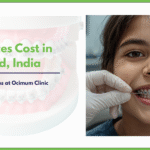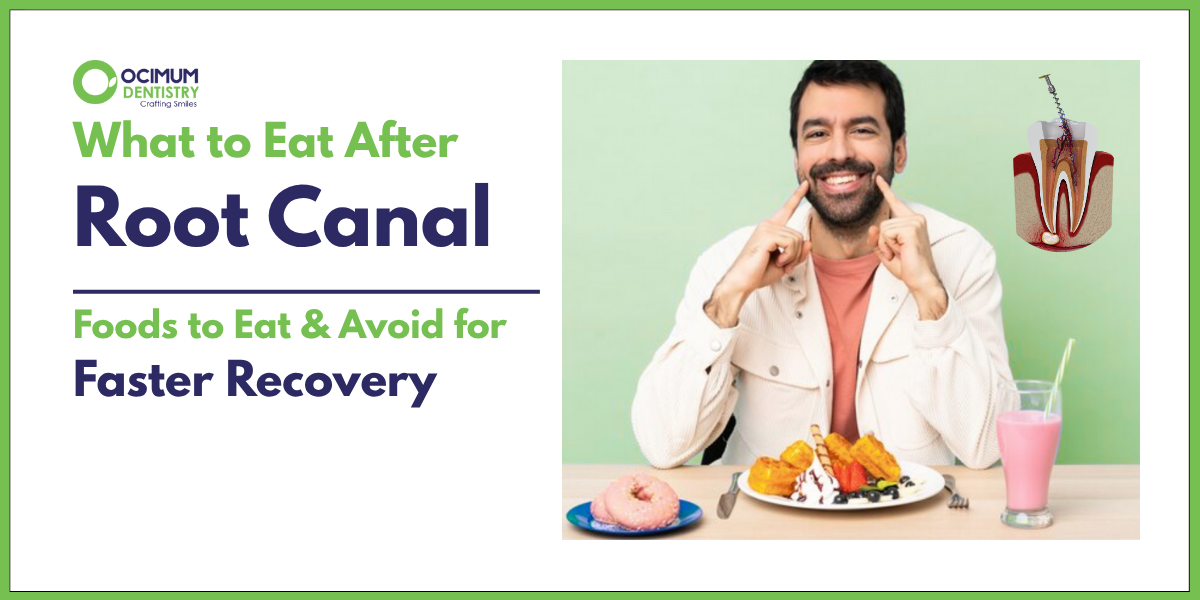Don’t Let the Wrong Foods Ruin Your Recovery!
Did you know that nearly 42% of root canal treatments in India involve lower molars, and over 80% of dental patients have undergone endodontic therapy at some point in their lives?
If you’ve just had a root canal, your success doesn’t depend solely on your dentist—it also depends on what you eat after root canal. Choosing the wrong foods can dislodge temporary fillings, irritate sensitive gums, and even delay healing.
In this guide, we’ll show you exactly what to eat after root canal, what foods to avoid, tips for safe recovery, and sample meal plans. By the end, you’ll know how to protect your investment in your oral health and feel comfortable eating again.
If you haven’t scheduled your root canal yet, you can check out Ocimum Dental’s Root Canal Services in Jubilee Hills for expert treatment.
Why Diet Matters After Root Canal
A root canal involves removing infected pulp, cleaning the canals, and sealing the tooth. Afterward, the treated tooth and surrounding gum tissue can be sensitive. Eating the wrong foods can:
- Dislodge a temporary filling or crown
- Irritate sensitive tissues, causing pain and inflammation
- Delay healing or create a risk of reinfection
Indian studies emphasize the importance of proper care: about 24% of root canals with curved canals experienced treatment errors, showing that careful post-treatment habits—including diet—are crucial for a successful recovery.
Knowing what to eat after root canal is therefore not just about comfort—it’s essential for proper healing and long-term success.
What to Eat After Root Canal: Safe & Beneficial Foods
Here’s a detailed list of foods that are gentle on your mouth, easy to chew, and supportive of healing:
1. Soft Carbohydrates
- Mashed potatoes or sweet potatoes
- Well-cooked rice, soft Indian khichdi, or porridge
- Soft pasta or upma
- Soft bread without crusts, or soft paratha (torn into small pieces)
2. Soft Proteins & Dairy
- Yogurt (plain, smooth)
- Soft cottage cheese or paneer
- Scrambled, poached, or soft-boiled eggs
- Soft tofu or lentil soup (dal)
- Softly cooked beans or lentil puree
3. Fruits & Smoothies
- Ripe bananas, mango puree, peach puree, or applesauce
- Smoothies (blended fruit with yogurt or milk)
- Soft canned fruits without chunks
4. Soups, Broths & Liquid Foods
- Pureed vegetable soups or cream soups (pumpkin, carrot, tomato)
- Bone broth or mild soft stews
- Puddings, custards, or flans
Sample Daily Meal Plan
Here’s a daily plan illustrating what to eat after root canal:
| Meal | Options |
| Breakfast | Banana smoothie with yogurt, soft upma or khichdi |
| Mid-morning | Applesauce or plain yogurt |
| Lunch | Pureed vegetable soup + soft khichdi or well-cooked rice + mashed dal |
| Afternoon Snack | Soft paneer cubes (mashed) or custard |
| Dinner | Soft pasta or rice + dal / soft vegetable stew |
| Dessert / Evening Snack | Pudding or milkshake (lukewarm or room temperature) |
Always cut foods into small pieces and chew slowly on the opposite side of the treated tooth.
How Long Should You Follow a Soft Diet?
- First 24 hours: Stick to liquids or ultra-soft foods only. Avoid chewing completely.
- Next 2–3 days: Introduce soft foods like mashed vegetables, dal, yogurt, and soups.
- 3–5 days: Gradually add slightly firmer foods, but avoid hard, crunchy, or sticky foods.
- After permanent crown or filling: You can slowly resume a normal diet, but avoid anything causing pain or sensitivity.
If you want guidance on scheduling your follow-up or final crown placement, contact Ocimum Dental or visit their location on Google Maps.
What to Avoid After Root Canal
Equally important is knowing what not to eat after root canal:
- Hard or crunchy foods: nuts, popcorn, raw vegetables, hard biscuits
- Sticky or chewy foods: caramel, gummies, toffees, chewing gum
- Extreme temperatures: very hot or very cold foods or drinks
- Spicy or acidic foods: chili, tomato, citrus, pickles, soda
- Tough meats: steak, jerky, fibrous meat cuts
- Using straws: can dislodge temporary fillings
- Alcohol or sugary drinks: may promote bacterial growth and slow healing
Tips for Safer Eating
- Wait for numbness to wear off before eating to avoid biting your tongue or cheek.
- Chew on the opposite side of the treated tooth.
- Cut foods into small pieces and chew slowly.
- Rinse gently with lukewarm salt water after meals.
- Maintain oral hygiene using a soft toothbrush and careful flossing.
- Stay hydrated with water and mild beverages.
- Follow your dentist’s instructions carefully—every case is different.
Q: Can I eat immediately after a root canal?
A: Wait until the anesthesia wears off to avoid accidental bites and protect the temporary filling.
Q: How long until I can eat normally again?
A: After your permanent crown or filling and reduced sensitivity, gradually resume normal food.
Q: What if I accidentally ate something hard and feel pain?
A: Stop immediately, rinse with lukewarm salt water, and contact your dentist if pain persists or the filling is dislodged.
Q: Can I eat cold foods like ice cream?
A: Mildly cold foods are okay once sensitivity improves. Avoid extremely cold items if they cause discomfort.
Choosing the right foods after a root canal is crucial for recovery. Indian statistics show the high prevalence of root canals, especially in lower molars, highlighting why post-treatment care is essential. By knowing what to eat after root canal, what to avoid, and following simple tips, you can protect fillings, reduce pain, and ensure smooth healing.
Schedule your root canal or follow-up care today by visiting Ocimum Dental for expert guidance and support.





